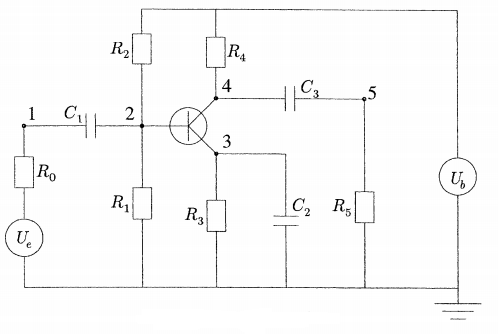경직성(Stiff) 트랜지스터 미분대수 방정식 풀기
이 예제에서는 전기 회로를 나타내는 경직성 미분대수 방정식(DAE)을 푸는 방법을 보여줍니다[1]. 예제 파일 amp1dae.m에 작성된 단일 트랜지스터 증폭기 문제는 반명시적(semi-explicit) 형식으로 재작성할 수 있지만, 이 예제에서는 원래 형식 로 이 문제를 풉니다. 이 문제에는 상수 특이 질량 행렬 이 포함됩니다.
트랜지스터 증폭기 회로에는 저항기 6개, 축전기 3개, 그리고 트랜지스터 1개가 있습니다.

초기 전압 신호는 입니다.
동작 전압은 입니다.
노드에서의 전압은 로 지정됩니다.
저항기 의 값은 일정하며 각 저항기를 통과하는 전류는 를 충족합니다.
커패시터 의 값은 일정하며 각 커패시터를 통과하는 전류는 를 충족합니다.
5번째 노드에 걸리는 출력 전압 를 구하는 것이 목적입니다.
MATLAB®에서 이 방정식을 풀려면 ode 객체를 사용하고 객체의 속성을 설정하여 방정식, 질량 행렬 및 초기 조건을 정의하면 됩니다. 그런 다음 solve 메서드를 사용하여 시간 경과에 따라 시스템을 시뮬레이션합니다. 필요한 함수를 이 예제와 같이 스크립트 내에 함수로 포함시킬 수도 있고, MATLAB 경로에 있는 디렉터리에 이름이 지정된 별도의 파일로 저장할 수도 있습니다.
질량 행렬 코딩하기
키르히호프의 법칙(Kirchoff's law)에 따라 각 노드(1~5)를 통과하는 전류를 등식으로 하여 회로를 나타내는 5개 방정식으로 이루어진 연립방정식을 구할 수 있습니다.
방정식 좌변의 도함수 항을 모아서 찾아낸 이 연립방정식의 질량 행렬의 형식은 다음과 같습니다.
여기서 에 대해 입니다.
적절한 상수 를 사용하여 질량 행렬을 만든 다음 질량 행렬을 저장하는 odeMassMatrix 객체를 만듭니다. 질량 행렬이 특이 행렬임이 명백하더라도, 솔버가 자동으로 DAE 문제를 감지하는지 테스트하려면 Singular 속성을 디폴트 값인 "maybe"로 유지합니다.
c = 1e-6 * (1:3); M = zeros(5,5); M(1,1) = -c(1); M(1,2) = c(1); M(2,1) = c(1); M(2,2) = -c(1); M(3,3) = -c(2); M(4,4) = -c(3); M(4,5) = c(3); M(5,4) = c(3); M(5,5) = -c(3); Mass = odeMassMatrix(MassMatrix=M);
방정식 코딩하기
함수 transampdae에는 이 예제에 사용되는 연립방정식이 포함되어 있습니다. 이 함수는 모든 전압 및 상수 파라미터 값을 정의합니다. 방정식 좌변에서 수집한 도함수는 질량 함수로 코딩되고 transampdae는 방정식의 우변을 코딩합니다.
function dudt = transampdae(t,u) % Define voltages and parameters Ue = @(t) 0.4*sinpi(200*t); Ub = 6; R0 = 1000; R15 = 9000; alpha = 0.99; beta = 1e-6; Uf = 0.026; % Define system of equations f23 = beta*(exp((u(2) - u(3))/Uf) - 1); dudt = [ -(Ue(t) - u(1))/R0 -(Ub/R15 - u(2)*2/R15 - (1-alpha)*f23) -(f23 - u(3)/R15) -((Ub - u(4))/R15 - alpha*f23) (u(5)/R15) ]; end
초기 조건 코딩하기
초기 조건을 설정합니다. 이 예제에서는 [1]에서 계산된 각 노드를 통과하는 전류에 대해 일관된 초기 조건을 사용합니다.
Ub = 6; u0(1) = 0; u0(2) = Ub/2; u0(3) = Ub/2; u0(4) = Ub; u0(5) = 0;
연립방정식 풀기
ODEFcn, MassMatrix, InitialValue 속성의 값을 설정하여 문제를 설명하는 ode 객체를 만듭니다. 문제를 푸는 데 사용할 솔버로 ode23t를 선택합니다.
F = ode(ODEFcn=@transampdae,MassMatrix=Mass,InitialValue=u0,Solver="ode23t")F =
ode with properties:
Problem definition
ODEFcn: @transampdae
InitialTime: 0
InitialValue: [0 3 3 6 0]
Jacobian: []
MassMatrix: [1×1 odeMassMatrix]
EquationType: standard
Solver properties
AbsoluteTolerance: 1.0000e-06
RelativeTolerance: 1.0000e-03
Solver: ode23t
Show all properties
solve 메서드를 사용하여 시간 구간 [0 0.05]에 대한 연립 DAE를 풉니다.
S = solve(F,0,0.05); t = S.Time; u = S.Solution;
결과 플로팅하기
노드 5인 까지 초기 전압 와 출력 전압 를 플로팅합니다.
Ue = @(t) 0.4*sinpi(200*t); plot(t,Ue(t),"o",t,u(5,:),".") axis([0 0.05 -3 2]); legend("Input Voltage U_e(t)","Output Voltage U_5(t)",Location="NorthWest"); title("One Transistor Amplifier DAE Problem Solved by ODE23T"); xlabel("t");

참고 문헌
[1] Hairer, E., and Gerhard Wanner. Solving Ordinary Differential Equations II: Stiff and Differential-Algebraic Problems. Springer Berlin Heidelberg, 1991, p. 377.